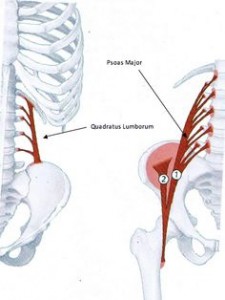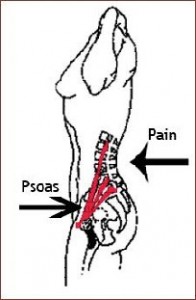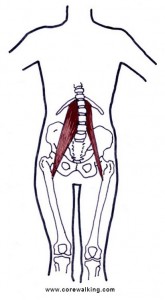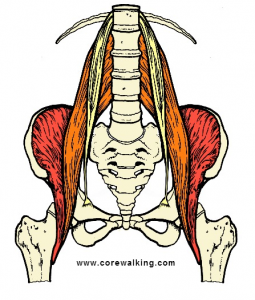 The psoas major muscle attaches along the lumbar spine, and lower back pain often involves this all-important muscle that too few people have heard of. The five bones that make up the lumbar spine sit between the pelvis and the rib cage, bearing and transferring weight from the upper to lower body.
The psoas major muscle attaches along the lumbar spine, and lower back pain often involves this all-important muscle that too few people have heard of. The five bones that make up the lumbar spine sit between the pelvis and the rib cage, bearing and transferring weight from the upper to lower body.
The psoas flexes and laterally rotates the leg at the hip and it flexes the spine. From a standing position the psoas lifts the leg bending the knee towards the chest. Lying on the floor the psoas helps to lift the trunk towards a situp.
The curve of the lumbar spine, without which we couldn’t stand or walk upright, is created by the psoas major when we come up to stand from a kneeling and crawling position. When the psoas shortens or engages it pulls the lumbar vertebrae forward and down. This engagement is what created our curved lower spine as the pelvis is pulled upright with the spine stacked vertically.
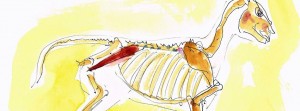 The lower back in a quadrupedal animal lacks a curve because the psoas doesn’t cross the pelvis to affect the lumbar spine.
The lower back in a quadrupedal animal lacks a curve because the psoas doesn’t cross the pelvis to affect the lumbar spine.
When it comes to the lumbar spine and lower back pain it is hard, if not impossible, for the psoas muscle to avoid complicity in the problem at hand. The same goes for many of the muscles in the vicinity of the psoas.
The quadratus lumborum, for example, is the next door neighbor of the psoas, connecting the pelvis to the ribcage and acting to bring stabilize these structures. The quadratus, or QL, attaches to similar points along the lumbar spine as the psoas and they are almost always part of the lower back pain puzzle.
The psoas can affect the lumbar spine in many ways as it connects to four of the lumbar vertebrae in two different places (both the body and the base of the transverse processes).
If the engaged psoas pulls the lumbar vertebrae forward, chronically tight psoas muscles will pull and keep the lumbar vertebrae forward into a hyper lordotic, or overly arched, state. If the psoas is tight on only one side it will pull the vertebrae forward on that side only and in turn will usually twist and torque the pelvis along with the lumbars. As one side tightens, the other side often fades into obscurity losing tone and strength.
Both of these inappropriate alignments of the psoas can, and often do, lead to lower back pain. These are basic misalignments that involve all of the connections of the psoas along the lumbar spine. But it is also possible for the psoas to have problems within the individual connections along the spine.
If the psoas attaches on the first through fourth lumbar vertebrae it is possible for two of those attachments to be happily aligned and two to be off kilter.
With all of these possibilities for dysfunction there are many ways to connect the psoas, the lumbar spine and lower back pain. Two tight psoas can compress the lumbar vertebrae create pain in the center of the spine. One tight psoas can compress the spine laterally creating lower back pain that would present slightly different symptoms.
One tight psoas can also pull a leg up into the hip socket limiting range of motion and creating discomfort. That same tight psoas can push forward into the inguinal ligament creating yet another kind of pain that often presents as a wrapping feeling from the front of the pelvis towards the back.
The psoas, the lumbar spine and lower back pain are usually synonymous in my book. And even if the psoas isn’t directly involved with the pain, getting the psoas aligned and working more functionally is almost always part of the healing puzzle.

